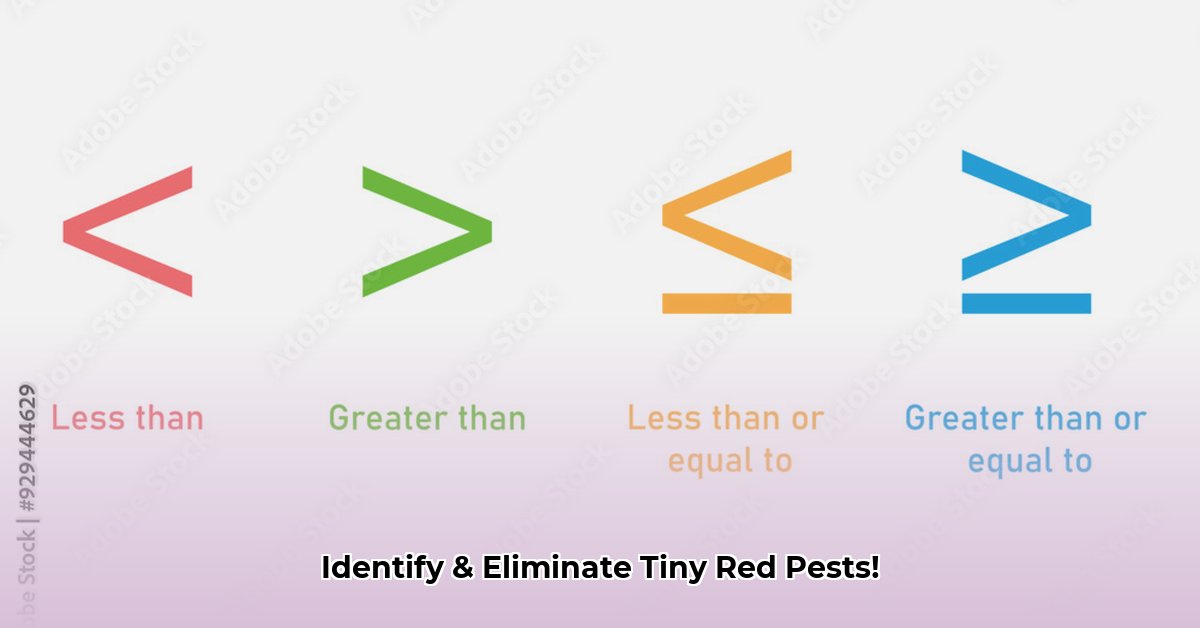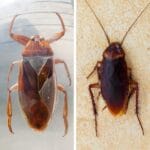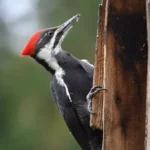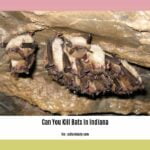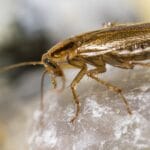Seeing tiny red bugs crawling around your house is never fun. This guide will help you identify what kind of bugs you’re dealing with and show you how to get rid of them, and prevent them from coming back. We’ll cover clover mites, chiggers, bed bugs, and red flour beetles, with clear, easy-to-follow steps. We’ll also share expert tips and tricks to keep those pests away for good. Let’s get started on getting your home bug-free!
Identify Pest Types and Control Methods
So, you’ve got tiny red bugs invading your space? Don’t panic! Identifying the specific type of bug is the first step to getting rid of them and preventing future infestations. Knowing how to identify and treat different types of tiny red bugs can make all the difference.
Identifying Your Tiny Red Invaders
Let’s look at some common culprits and how to tell them apart:
-
Clover Mites: These tiny, red specks are often seen near windows and doorways, especially in spring. They’re small, almost microscopic, and round, with eight legs. While they don’t bite, they leave a red stain when crushed.
-
Chiggers: These microscopic mites cause itchy welts. You’ll find them outdoors in tall grasses and weeds. They can easily hitch a ride indoors on your clothes or pets. Their bites cause intense itching and small, red bumps.
-
Bed Bugs: While not always bright red (nymphs can be reddish-brown), these nocturnal bloodsuckers are found near beds. If you see small, reddish-brown insects and you’re waking up with itchy bites in a line or cluster, you likely have bed bugs.
-
Red Flour Beetles: These pantry pests infest flour, grains, cereals, and other stored foods. You might not even notice them until you see their larvae infesting your food. Adult beetles are small, reddish-brown, and elongated, typically 3-4mm long.
Getting a positive identification is crucial. A magnifying glass can help, but if you’re still unsure, take a picture and consult a pest control expert or use an online search with good images.
Controlling Small Red Bug Infestations
Once you know what you’re dealing with, you can choose the right method to get rid of them. Here’s a breakdown for each type:
1. Clover Mites:
- Vacuum Power: Thoroughly vacuum carpets, furniture, and windowsills—especially where you see the mites. Pay close attention to cracks and crevices.
- Seal the Gaps: Caulk any cracks or gaps around windows, doors, and your home’s foundation. This prevents future invasions.
- Landscaping Matters: Keep grass and shrubs trimmed away from the house. Create a plant-free perimeter of at least 2 feet using gravel or mulch.
- Insecticides (Use with Caution): If infestations are severe, use an insecticide labeled for mites. Apply around the foundation, windows, and doors. Always follow the product label’s instructions and wear protective gear. Consider less-toxic options first, such as insecticidal soap or diatomaceous earth.
2. Chiggers:
- Protective Gear: Wear long sleeves, pants, socks, and shoes, and use insect repellent containing DEET or picaridin when in chigger-prone areas.
- Shower Power: After spending time outdoors, shower thoroughly and immediately wash your clothes in hot water.
- Soothe the Itch: Calamine lotion, hydrocortisone cream, or antihistamine sprays can help relieve the itching from chigger bites. Resist the urge to scratch.
- Yard Treatment: If chiggers are a consistent problem in your yard, consider treating the affected areas with an appropriate insecticide, following label instructions carefully.
3. Bed Bugs:
- Professional Help is Key: Bed bugs are tough to eliminate on your own. Contact a pest control professional immediately for the best chance of eradication.
- Wash and Dry: Wash and dry all bedding, linens, and clothing at high heat (above 120°F) for at least 30 minutes to kill any bed bugs and their eggs.
- Mattress Encasements: Use specialized mattress and box spring encasements. These create a barrier, preventing bed bugs from accessing your mattress and breeding.
- Vacuuming: Thoroughly vacuum the mattress, box spring, carpets, and furniture, paying close attention to seams and crevices.
- Steam Cleaning: Use a steam cleaner on mattresses, carpets, and furniture to kill bed bugs and their eggs.
4. Red Flour Beetles:
- Toss the Infested: Throw away any food items that are infested with beetles or larvae.
- Vacuum Thoroughly: Vacuum shelves, pantry crevices, and anywhere else you find beetles or larvae.
- Deep Clean: Wash shelves and containers with hot, soapy water and dry them completely before restocking.
- Airtight Storage: Store all food items in airtight containers made of glass, metal, or sturdy plastic to prevent future infestations. Consider storing susceptible items in the refrigerator or freezer.
- Pheromone Traps: Use pheromone traps designed to attract red flour beetles. These can help monitor and reduce the beetle population.
Preventing Future Small Red Bug Problems
Prevention is easier (and cheaper!) than dealing with an infestation. Here’s how you can proactively keep these tiny invaders out.
- Regular Cleaning: Keep your home clean. Regularly vacuum, dust, and clean surfaces.
- Yard Maintenance: Keep your lawn mowed, remove leaf litter and debris, and address any moisture problems around your foundation.
- Seal Cracks and Gaps: Regularly inspect the exterior of your house, sealing any cracks or gaps where bugs might enter. This includes around windows, doors, and utility lines. Use caulk or weather stripping to seal openings.
- Proper Food Storage: Store all food in airtight containers. Check regularly for any signs of infestation, like webbing or small insects.
- Monitor Humidity: Maintain proper humidity levels in your home. High humidity can attract some pests, while low humidity can deter others. Use a dehumidifier or humidifier as needed.
- Inspect Items Brought Indoors: Inspect plants, firewood, and other items brought indoors for signs of pests before bringing them inside.
- Professional Inspections: Consider regular pest control inspections to identify potential problems early.
Risk Assessment Matrix (Example: Clover Mites)
This table helps you understand the likelihood and impact of different risk factors for clover mite infestations.
| Risk Factor | Likelihood | Impact | Mitigation |
|---|---|---|---|
| Entry via cracks/gaps | High | Medium | Seal all gaps and cracks around the foundation. |
| Abundant yard vegetation | High | High | Maintain a plant-free zone around the foundation. |
| High humidity | Medium | Medium | Improve ventilation; address moisture issues. |
| Unidentified infestation | Low | High | Conduct thorough inspections; seek professional help. |
Remember, early detection is your best friend. If you’re struggling to identify the bugs or control an infestation, don’t hesitate to call in a pest control professional. They have the expertise and tools to deal with even the most stubborn infestations. And remember, a clean home is a happy home—and a bug-free one, too!
How to Identify and Treat Different Types of Tiny Red Bugs in My Home
Key Takeaways:
- Many tiny red bugs infest homes, each requiring unique solutions.
- Accurate identification is crucial for effective treatment.
- Prevention is key to long-term control.
- Several methods help control infestations, from simple cleaning to targeted pesticides.
- Always follow product instructions carefully and prioritize safety.
Identifying Your Tiny Red Invaders
Have you noticed tiny red bugs crawling around your house? Before you panic, let’s figure out what you’re dealing with. Different red bugs require different approaches. Some are harmless, others can bite. Let’s focus on how to identify and treat different types of tiny red bugs accurately.
Common Culprits:
- Clover mites: These are tiny, non-biting mites that often appear in large numbers. They’re typically found near foundations and leave reddish stains when crushed.
- Chiggers: These are larval mites that bite, causing intense itching. They’re prevalent in grassy areas and typically found outdoors.
- Red flour beetles: These tiny beetles infest stored food products, particularly flour and grains.
Tackling Different Types of Tiny Red Bugs
The approach depends on the type of bug.
Clover Mites
- Identification: Tiny, dark red, oval shape, often found in clusters near windows and foundations. Leave a red stain when crushed.
- Treatment: Vacuum thoroughly, seal cracks and crevices to prevent entry, and create a plant-free perimeter around the foundation. Use insecticidal soap if necessary.
Chiggers
- Identification: Minute, often invisible to the naked eye; bites cause intense itching welts. Typically encountered outdoors in grassy or wooded areas.
- Treatment: Shower immediately after
- Discover Life in a Medieval Castle: Beyond Battles & Banquets: Unveiling Daily Life - August 2, 2025
- Scipio Africanus: Hannibal’s Nemesis: Rise, Fall, and Legacy - August 2, 2025
- Unveiling Superorganisms: Are Ant Colonies One Mind? - August 2, 2025
